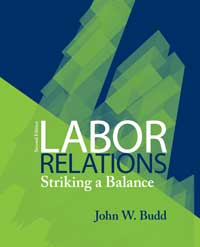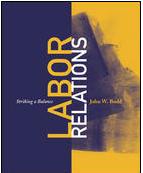|
John W. Budd
** Click here for information on the new third edition **
 
|
|
Click here for the marketing flyer
Go to the McGraw-Hill/Irwin catalog page Go to the text's accompanying website (www.mhhe.com/budd2e) Request a Review/Desk Copy |
|
|
Reviews: Journal of Labor Research (Winter 2006) WorkingUSA (September 2004) |
Available at: Amazon.com Barnes and Noble Powell's Books |
An award-winning labor relations textbook for undergraduates and graduates...
The traditional approach to studying U.S. labor relations focuses on an uncritical exploration of how the existing labor processes work: how unions are organized, how contracts are negotiated, and how grievances are resolved. And since U.S. unions have typically used these processes to win detailed work rules, there is a tendency to equate labor relations with work rules, and to therefore structure labor relations courses and textbooks around the examination of these work rules. In other words, traditional labor relations textbooks are dominated by rich descriptions of the how, what, and where of the major labor relations processes. But what's missing is the why. Labor relations is not about work rules. Labor relations processes and work rules are simply means to more fundamental ends or objectives. What are these objectives? Under what conditions are collectively-bargained work rules a desirable or undesirable method for achieving these objectives? In the world of work of the 21st century, are there better ways of pursuing these objectives? These are the central and engaging questions of labor relations-questions ignored by textbooks that narrowly focus on how the existing labor relations processes and detailed work rules operate in practice.
The importance of moving beyond a process-based focus in studying labor relations is underscored by the fact that today's labor relations processes are under attack from all directions. Business professionals, labor leaders, and diverse academics frequently criticize the operation of contemporary U.S. labor relations, albeit usually for different reasons. Analyzing whether the labor relations system needs updating and evaluating alternative options for reform require an intellectual framework that is rooted in the objectives of the employment relationship. A description of how the current processes work without any discussion of what the processes are trying to achieve fails to provide the basis for determining whether the processes are working, and fails to supply metrics for judging alternative strategies, policies, and processes.
This textbook presents labor relations as a system for striking a balance between the employment relationship goals of efficiency, equity, and voice, and between the rights of labor and management. It is important to examine these goals to discover what motivates contemporary U.S. labor relations processes, and to evaluate whether these processes remain effective in the 21st century. What are the differing assumptions (such as whether labor markets are competitive) that underlie alternative mechanisms for achieving efficiency, equity, and voice? Why is a balance important? How do both the external environment and individual decision-making determine labor relations outcomes, and therefore the extent to which these goals are balanced? These questions provide the framework for analyzing the existing processes-especially organizing, bargaining, and contract administration-as well as the major pressures on these processes-employee involvement, workplace flexibility, and globalization. An important theme is that the current processes are one option for balancing workplace objectives and rights, but that this system is under fire from many directions. The book therefore concludes with chapters to promote reflection on the strengths and weaknesses of the current system and the possibilities for reform. This material includes a comparative examination of labor relations systems from other countries and a consideration of varied U.S. reform proposals that include changes in union and corporate behavior as well as public policies.
This textbook therefore replaces the tired paradigm of "labor relations equals detailed work rules" with the dynamic paradigm of "labor relations equals balancing workplace goals and rights." This is not to say that the existing processes are unimportant. Labor law, union organizing, bargaining, dispute resolution, and contract administration are central topics that are thoroughly covered in the heart of this book using diverse historical and contemporary examples. Current and future labor relations practitioners will certainly learn the ins and outs of the traditional labor relations processes. But this is no longer sufficient for effective practice because labor relations practices are in flux. As such, the labor relations processes are not presented in this textbook as self-evidently good; they are placed in the broader context of the nature of the employment relationship to foster a deep understanding of labor relations. The logic and relevance of the existing labor relations processes are more readily understood when explicitly linked to the beliefs about the employment relationship that underlie these processes. This deep understanding further provides the foundation for critically evaluating future directions for labor relations and labor policy-what labor relations strategies, policies, and practices can most effectively strike a balance among the workplace goals and rights of workers and employers in the environment of the 21st century?
TABLE OF CONTENTS
Part I: Foundations
Chapter 1: Contemporary Labor Relations: Objectives, Practices, and Challenges
Chapter 2: Labor Unions: Good or Bad?
Chapter 3: Labor Relations Outcomes: Individuals and the Environment
Part II: The U.S. New Deal Industrial Relations System
Chapter 4: Historical Development
Chapter 5: Labor Law
Chapter 6: Labor and Management: Strategies, Structures, and Rights
Chapter 7: Union Organizing
Chapter 8: Bargaining
Chapter 9: Impasse, Strikes, and Dispute Resolution
Chapter 10: Contract Clauses and Their Administration
Part III: Issues for the 21st Century
Chapter 11: Flexibility and Employee Involvement
Chapter 12: Globalization
Part IV: Reflection
Chapter 13: Comparative Labor Relations
Chapter 14: What Should Labor Relations Do?
Appendix A: Selected Laws and Declarations
Appendix B: Collective Bargaining Simulation: The Zinnia and Service Workers Local H-56
KEY FEATURES
The updated 2nd edition is now available! To order your complimentary examination copy, simply ask your local McGraw-Hill/Irwin representative, call customer service at 1-800-338-3987, or follow this link.
ISBN-13 9780073404899
©2008 / Hardcover / 608 pages
Click here for the marketing flyer
Go to the McGraw-Hill/Irwin catalog page
Go to the text's accompanying website (www.mhhe.com/budd2e)
January 18, 2007
Return to John Budd's home page